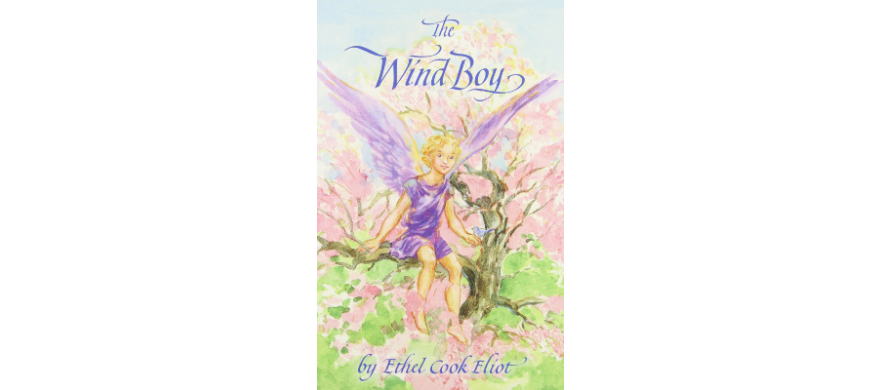There’s joy in discovering the latest, greatest work in children’s literature–like walking a beach and pulling a rare, perfect shell from the surf. But there’s a special excitement that comes from finding an old treasure, made obscure by the passage of time, buried under the layers of new works pouring in year by year. It’s the thrill of the fossil hunter. This has been here all along, I marvel, and I didn’t even know! The old book’s loveliness is not dimmed by age, the truth it tells preserved for those who pick it up and examine it.
Perhaps your family will feel that thrill reading Ethel Cook Eliot’s The Wind Boy. Published nearly 100 years ago, it’s not a well-known work. The plot is wholesome, beautiful in its apparent simplicity. Siblings Kay (10) and Gentian (8) and their mother Detra, are refugees come to live in a village, hoping against hope to hear news of their soldier-father. Theirs is a fictional land, redolent of post-WWII Europe. The people of the village shun the little family, and they live in lonely poverty.
That all changes when Nan, a girl “from the mountains,” comes to care for the house and children while Detra finds work. Nan can tell wonderful stories, and she makes the small house a happy home. Best of all, Nan introduces the children to the Clear Land and its people. For above the village, there is a village much like it, which one can enter if one can see it. (But of course, not everyone can.) With Clear children for playmates, Kay and Gentian are no longer lonely, and their life in the village below becomes easier too.
They befriend the Wind Boy, a Clear child in disgrace until he destroys an ugly mask he made as a joke. Someone— no one knows who— found his mask and is using it to frighten children in the village. Together, Kay, Gentian, Nan, and the Wind Boy must find the culprit and destroy the mask.
There’s much to love about this story. Young readers (7-10 being the sweet spot, in my opinion) will enjoy the world-building and mystery, and they’ll identify with the conflicts that arise: the need to belong, the injustice of being wrongfully accused, the desire to help a parent in trouble. They can observe the progression of sin, atonement, and forgiveness as the Wind Boy makes amends for his prank— all from the safe vantage point of observer. Eliot’s characters do not suffer from what I call Orphan Syndrome— the convenient absence of a child protagonist’s relations; she places hers in the nexus of a loving, imperfect family made up of loving, imperfect people.
Parent-readers of 2020 will find a kindred spirit in Detra, who struggles to make a living, perform the tasks of homemaker, and pursue her calling as an artist— a tension Eliot herself must have felt a century ago. Consider her description of Detra’s finding a patron:
When you have created a beautiful thing, that is happiness. But the next happiness is to find someone who understands what you have done, and knows that it is beautiful.
Eliot has created a beautiful thing in The Wind Boy, and her readers can have that “next happiness.” Parents and children will, I think, find her ending satisfying and affecting.
Most importantly, Eliot gives us a setting in which earthly and spiritual realms overlap, and she does it with a light touch of an artist and believer. What better introduction to a concept of heaven than fantastical worlds in which one realm rests within another? We can give our children visions of Aslan’s country only a wave’s crest away, tell them of a ball of string unerringly leads to a loving great-great-grandmother, and describe the silver glass of Tolkien’s western lands.
I would humbly suggest adding The Wind Boy to this faith-strengthening list. It, too, captures readers’ imaginations, urging them to “Come further up, come further in!” Adults will recognize Eliot’s nod to Plato and his world of forms as Detra attempts to sculpt the Wind Boy. (Nan asks the children, “‘But don’t you yourselves know that since she has made him so true there must be a truer one…?’”) Children will smile one day in some future philosophy or theology class, remembering the Clear Land. Again, in Nan’s words:
“Yes, the Clear Land does seem very like this land at first glance, Gentian. But then when you know it a little better you will find it is not like this at all, so very, very different. But then comes the strange part; when you know it even better than well, when you are perfectly at home there then you see again that it is very like this lower land.”
After all, isn’t that the purpose of narrative, as a vehicle for truth? Jesus spoke in parables, uttering “what has been hidden since the foundation of the world” (Matthew 13:34, Psalm 78:2). In loving imitation, faithful authors veil eternal truths in memorable stories. Narnia, Middle Earth, the Clear Land— all prepare our imaginations for the setting of our Author’s great story, unfolding into eternity beyond the veil.
- Sharing Family Stories - February 24, 2021
- The Wind Boy by Ethel Cook Eliot: A Review - December 16, 2020

What a great review of a book we have treasured and read to our bunch of youngsters while homeschooling. You make good points about the fantasy as intro to the spiritual.
Thank you for reminding me of this hidden gem in the ever-growing world of books. It has been far too long since this book was read to me in elementary school and now I’m determined to own a copy and share it with my children. A lovely review of a beautiful story.
Thank you for stirring my interest, Taryn. I will search for this book to add to my Oma library.
Just purchased! Can’t wait to read, as it sounds just lovely!!